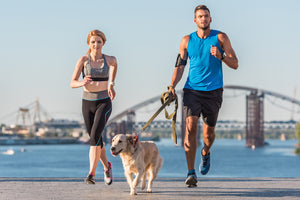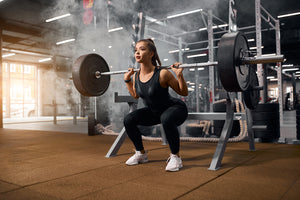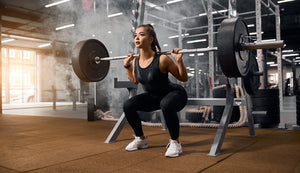Deadlifts are nothing new to anyone who has been lifting for a reasonable period of time. But there are a number of deadlift variations which some claim to be better than the conventional deadlift. And probably the most popular variation is the Romanian deadlift, or RDL.
You might be confused what the difference really is between the deadlift and Romanian deadlift, and why some people think this is a better exercise. The truth is, while there is a difference, there’s no evidence that one exercise is “better” than the other - they both have their own unique benefits.
Keep reading to learn all you need to know about conventional and Romanian deadlifts, and how to fit these exercises into your strength training routine.
What is an RDL?
The RDL, or Romanian deadlift, is a deadlift variation that alters the form slightly to put a greater emphasis on the lower body.
It’s named after Romanian weightlifter Nicu Vlad, who popularized this exercise around the time he was active in competition in the 1980s/90s.
Technically, the Romanian deadlift is not actually a deadlift, as it doesn’t involve lifting a weight off the ground. Instead, the motion begins with the weight already off the ground. However, it’s still referred to as a type of deadlift because the movement pattern is similar.
What’s the Difference Between Deadlift and Romanian Deadlift?

Romanian deadlifts have a few minor form differences that make them unique from a traditional deadlift, though they might seem the same at first glance.
Here’s a summary of the key differences between Romanian and conventional deadlifts:
- The conventional deadlift starts with the bar on the floor; the Romanian deadlift starts standing, with the weight held in your hands.
- With traditional deadlifts, the bar touches the ground between each rep. With Romanian deadlifts, the bar doesn’t touch the ground until the end of your set.
- With a Romanian deadlift, your knees remain locked in place, almost straight. Traditional deadlifts start with your knees contracted, and they straighten as you rise up and lift the bar.
- Romanian deadlifts target the hamstrings and glutes more extensively, while the traditional deadlift targets a wider range of muscles, including more work for the quads and upper back.
Now let’s look a little deeper into the form of each exercise and what they do for your body.
How to Do a Conventional Deadlift
Here’s how to perform conventional deadlifts:
- Start with your feet hip or shoulder-width apart, feet slightly underneath the bar.
- Hinge at the hips and grab the bar with a shoulder-width grip.
- Bend your knees into a partial squat, shins touching (or close to touching) the bar.
- Straighten your lower back, engage your core and push out your chest.
- Drive through your feet to generate power and raise up to a standing position, shoulders back, spine straight and knees locked.
- Lower the bar back to the floor in a controlled motion.
Benefits of Conventional Deadlift
- Compound exercise which works a wide range of muscle groups, plus core stability and grip strength.
- Great for building strength and size along the posterior chain.
- A functional movement that transfers to real-world activities and other sports.
- Improves size.
- Boosts metabolism.
- Improves bone density and reduces the risk of osteoporosis.
How to Do a Romanian Deadlift
Here’s how to perform a Romanian deadlift:
- Start standing, knees slightly bent, feet hip-width apart.
- Hold the bar in your hands in an overhand grip, shoulder-width apart.
- Keep your back straight, knees locked and push your butt back, hinging at the hips.
- Lower the bar close to your shins and bring your body close to a 45-degree angle.
- Without letting the bar hit the ground, pause slightly at the bottom of the movement, then use your lower body to drive the bar back up and return to the starting position.
Benefits of Romanian Deadlift
- Powerful lower body exercise, particularly for the hamstrings and glutes.
- Secondary benefits for many other muscle groups, including forearms, core, calves and back.
- Stretches the hamstrings and improves mobility.
- More time under tension, which boosts hypertrophy (muscle growth).
- Tend to be safer than traditional deadlifts, better for people recovering from lower back injuries.
- Versatile and easy to do with many different types of weights.
RDL Tips and Mistakes to Avoid
- Start light with Romanian deadlifts (don’t try to lift the same amount as your regular deadlift).
- Keep the bar close to your body, don’t let it drift out.
- Don’t lift with your back - use your lower body to generate power.
- Keep your back straight throughout the movement.
- Don’t let the bar touch the floor between reps.
- Keep a slight bend in the knees when you start, don’t bend them any further as you lower the weight.
RDL vs Stiff Leg Deadlift
RDLs are sometimes referred to interchangeably with stiff leg deadlifts. However, these are two different exercises, with one slight distinction in the movement.
The movement for the stiff leg deadlift is mostly the same, with the one difference being that you begin with the weight on the floor, rather than starting from a standing position.
In this aspect, the stiff leg deadlift is more like the conventional deadlift, except you start with your legs nearly straight, and maintain that angle (or rather, lack of angle) throughout the movement.
The rest of the movement is the same as the RDL, with the one exception being that you’re going up-down rather than down-up.
Romanian Deadlift Variations

One of the best things about Romanian deadlifts is their versatility - you don’t have to use a barbell, you can use just about any type of weight.
This could include:
- Dumbbells
- Kettlebell (or a single kettlebell, held in two hands)
- Plate (or a single plate held in two hands)
Whatever kind of weight you use, the movement is still essentially the same. This flexibility means you may be able to fit RDLs into your workouts more easily, particularly if you’re in a busy gym and/or have limited access to a barbell.
Deadlift vs Romanian Deadlift: Which is Better?

So now we know the difference between Romanian deadlift vs the conventional deadlift exercise - so which one is better?
The truth is, neither exercise is necessarily better than the other. They’re each better in certain aspects, but there’s a time and a place for either one.
When to Do Deadlifts
Regular deadlifts are generally better if you’re trying to build overall size and power, including the upper body.
If you have limited time to work out, you might find regular deadlifts are a better option, as they deliver more all-round benefits and work more muscle groups in a single exercise.
When to Do Romanian Deadlifts
Romanian deadlifts fit for leg days, particularly if you’re trying to focus on hamstrings and glutes.
They’re also good if you’re recovering from an injury, and don’t want to do heavy deadlifts, or if you don’t have access to a regular barbell.
Keep in mind, RDLs don’t have to be an alternative to the conventional deadlifts. You can do RDLs in between days you do conventional deadlift to provide supplementary benefits and improve your normal deadlifts.
Is RDL Safer than Conventional Deadlift?
Most people agree that Romanian deadlifts are safer than regular deadlifts.
That’s not to say that regular deadlifts are unsafe, or that Romanian deadlifts are completely safe. Both have risks, but both can also be completely safe if done correctly.
But, generally, you’re doing Romanian deadlifts with lower weight and putting less stress on the lower back, which means they’re overall a safer option, especially for people with existing injury concerns.
How Heavy to Go with Romanian Deadlift

According to Strength Level’s benchmarks, the average deadlift for a 174 lb male is 335.8 lb, while the average RDL is 265.6 lb (a difference of 21%).
The difference for females (average body weight of 140 lb) is 192.6 lb vs 145.6 lb (a difference of 24%).
With that in mind, aim for 20-25% less weight when doing RDL vs conventional deadlift. When you’re first doing Romanian deadlifts, go even lighter - you’ll want to go very light while you learn proper form, then slowly build up to your max weight in line with the benchmarks above.
Final Thoughts
Conventional and Romanian deadlifts are both amazing exercises, which are great for building size, strength, power, functional mobility and athleticism.
And the best part is, you don’t have to choose one or the other.
While you can use RDLs as a substitute for regular deadlifts, if you want to limit stress on the lower back, or you want to focus more on the glutes and hamstrings, the two exercises complement each other well and can be done on alternating days.
You can also experiment with other deadlift variations, such as the trap bar deadlift, suitcase deadlifts, sumo deadlifts, single-leg deadlifts and stiff leg deadlifts, as well as hip-hinge exercises like kettlebell swings and good mornings, for complete coverage of the posterior chain.
Playing around with and, ultimately, mastering similar yet slightly different exercises like these is a great way to build a complete physique and athletic profile, and quickly reach, then eclipse, your fitness goals.










